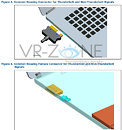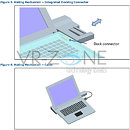Wednesday, November 23rd 2011

Intel Standardizing Thunderbolt Docking on Ultrabooks
The only way mainstream portable wintels are going the survive the onslaught of smaller, increasingly powerful and energy-efficient computing devices (such as ARM-driven tablets and smartphones), is by slimming down radically, and making themselves available to the mainstream. No, we're not talking about cheapo netbooks, but ultrabooks (ultra-slim notebooks), that provide mainstream notebook-like performance in a much more compact package. Intel will give this form-factor a big push next year with an Ivy Bridge architecture-based processor platform designed keeping it in mind, and technologies centric to it.
To begin with, slimmer form-factors could eat into wired connectivity, hence, Intel will push its Thunderbolt 10 Gb/s interconnect to the fore. But wired connectivity is the least of ultrabook's limitations. Battery life, data storage, and additional computing power will need to be accessible yet optional to it, and hence docking stations will be hot in the market, yet again. Intel will pitch for Thunderbolt to be a standard component of docking port clusters.Typically, these are pairs of ports, consisting of one Thunderbolt, and a complex-port of non-Thunderbolt connections that will be drawn into either slots (slot-type docking) or ports (cabled docking). The Thunderbolt connector will be able to convey DisplayPort signals, as well as 10 Gb/s of raw bandwidth for any device that needs it. A single port can be daisy-chained across multiple devices to effectively make use of that bandwidth. The exact composition of the non-Thunderbolt could vary, but it could contain connections such as DC power (supplementary battery), USB, SATA, PCI Express (direct from the system's root-complex), and miscellaneous connectivity. Manufacturers of ultrabooks and docking stations will be expected to follow this specification.
Source:
VR-Zone
To begin with, slimmer form-factors could eat into wired connectivity, hence, Intel will push its Thunderbolt 10 Gb/s interconnect to the fore. But wired connectivity is the least of ultrabook's limitations. Battery life, data storage, and additional computing power will need to be accessible yet optional to it, and hence docking stations will be hot in the market, yet again. Intel will pitch for Thunderbolt to be a standard component of docking port clusters.Typically, these are pairs of ports, consisting of one Thunderbolt, and a complex-port of non-Thunderbolt connections that will be drawn into either slots (slot-type docking) or ports (cabled docking). The Thunderbolt connector will be able to convey DisplayPort signals, as well as 10 Gb/s of raw bandwidth for any device that needs it. A single port can be daisy-chained across multiple devices to effectively make use of that bandwidth. The exact composition of the non-Thunderbolt could vary, but it could contain connections such as DC power (supplementary battery), USB, SATA, PCI Express (direct from the system's root-complex), and miscellaneous connectivity. Manufacturers of ultrabooks and docking stations will be expected to follow this specification.


13 Comments on Intel Standardizing Thunderbolt Docking on Ultrabooks
What is that figure 3? Trying to solve a transition-problem that doesnt exist?! In fact, they are MAKING a transition problem!
In all honesty, Intel doesn't seem to have figured out how to use its own tech and this is a really messy solution.
And if the Ethernet port has to be wired directly to the notebook's controller, then why not just plug the network cable in directly? That said, I don't know a lot of notebook users that rely on wired connections these days, but I'm sure this is a must for the corporate market or something...
The connector design is awful and the whole solution feels dated before it's even been made, but there you go, Intel doesn't innovate all the time...
So it should be possible to do graphics switching just like you can on Z68.
Still, as I said, with the high components cost, I can't see too many motherboard makers adding Thunderbolt support, although Intel should have some lower cost chips next year as well...